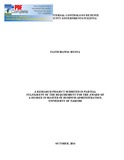| dc.description.abstract | This study sought to examine the part played by internal control system inthe
collection of revenue by county governments in Kenya. The objective of this study
therefore was to closely look at the internal controls in revenue collection by county
governments Kenya with a view to establish whether such internal controls have
produced any meaningful results in increased collected revenue. The research was
conducted using both qualitative and quantitative approaches. Questionnaires were
used on a population of 47 respondents in gathering primary data for the study. The
data collected was then analyzed and findings have revealed that the five components
of control environment, risk assessment, control activities, information and
communication and monitoring must be available for internal controls to work. The
study established that weak internal controls activities and lack of proper information
and communication systems have encouraged collusion to fraud, loss of revenue and
embezzlement of collected revenue. The study therefore concludes that internal
controls do function although with hiccups and that there is a significant effect
between internal controls and revenue collection in county governments in Kenya. | en_US |

